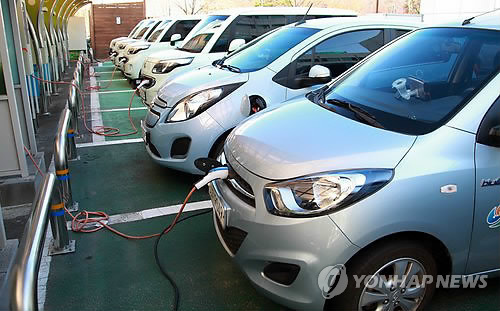The South Korean government on Tuesday notified local companies of their carbon dioxide emission quotas as the country is set to launch a platform next year to trade carbon credits amid growing concerns in the business sector.
The Ministry of Environment said 525 Korean companies would be subject to the emissions restriction from 2015 to 2017, the first phase of the trading system.
The aggregate quota for the 525 businesses is set at 1.598 billion tons over the next three years. The quota system involves 84 firms in the petrochemicals sector, 40 in steel, 38 in power generation and energy, 24 in automobiles, 20 in electromechanics and electronics and five in airlines.
The scheme will officially take effect in January next year and companies who have received their quotas will be allowed file objections within a month after the notification, the ministry said in a statement.
Choi Heung-jin, director general at the ministry, said Korea’s cooperation in the concerted efforts to battle global warming could generate fresh economic opportunities, even though some companies express worries over the additional regulatory costs.
“The cap on carbon dioxide emissions has been introduced as part of the government’s three-year plan to renovate the economy,” he said. “It would help the nation overhaul the current carbon-integrated economic structure.”
A task force held a meeting on Nov. 28 to finalize the detailed quotas for local companies.
After the first phase from 2015 through 2017, the government will impose carbon caps on additional companies in the second phase.
The 525 firms in the first phase take up about 65 percent of the nation’s combined greenhouse gas emissions quota.
The Ministry of Environment said 525 Korean companies would be subject to the emissions restriction from 2015 to 2017, the first phase of the trading system.
The aggregate quota for the 525 businesses is set at 1.598 billion tons over the next three years. The quota system involves 84 firms in the petrochemicals sector, 40 in steel, 38 in power generation and energy, 24 in automobiles, 20 in electromechanics and electronics and five in airlines.
The scheme will officially take effect in January next year and companies who have received their quotas will be allowed file objections within a month after the notification, the ministry said in a statement.
Choi Heung-jin, director general at the ministry, said Korea’s cooperation in the concerted efforts to battle global warming could generate fresh economic opportunities, even though some companies express worries over the additional regulatory costs.
“The cap on carbon dioxide emissions has been introduced as part of the government’s three-year plan to renovate the economy,” he said. “It would help the nation overhaul the current carbon-integrated economic structure.”
A task force held a meeting on Nov. 28 to finalize the detailed quotas for local companies.
After the first phase from 2015 through 2017, the government will impose carbon caps on additional companies in the second phase.
The 525 firms in the first phase take up about 65 percent of the nation’s combined greenhouse gas emissions quota.

The international emissions trading scheme requires businesses to reduce greenhouse gas emissions or buy credits to release more gases if they have difficulty meeting the target levels.
For Korea, businesses that emit less than the cap will be entitled to sell the remaining amount to the Korea Exchange, while other firms emitting more than their limits can buy the emission credits through the main bourse.
By sector, power generation and energy have the highest cap at 738.5 million tons, steel at 305.7 million tons, petrochemicals at 143.7 million tons and cement at 128 million tons.
The original quota for Korea is 1.687 billion tons. The government has allocated 1.598 billion tons to the 525 firms and set aside the other 89 million tons as a reserve.
According to the plan, the firms must reduce emissions on a gradual basis: 573.4 million tons in 2015, 562.1 million tons in 2016 and 559 million tons in 2017.
Korea, one of the world’s top 15 greenhouse gas emitters, announced in 2009 that it would reduce its greenhouse gas emissions by 4 percent by 2020.
By Kim Yon-se (kys@heraldcorp.com)





![[KH Explains] No more 'Michael' at Kakao Games](http://res.heraldm.com/phpwas/restmb_idxmake.php?idx=644&simg=/content/image/2024/04/28/20240428050183_0.jpg&u=20240428180321)













